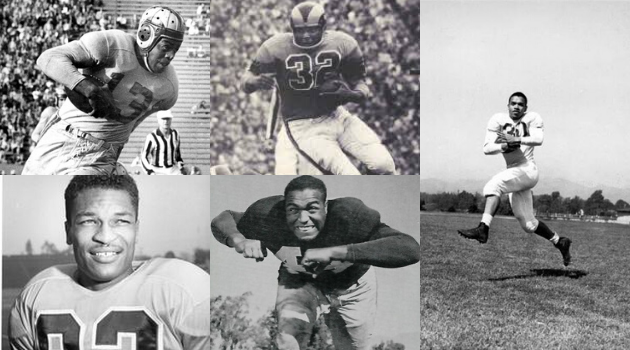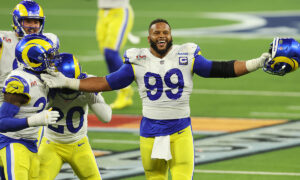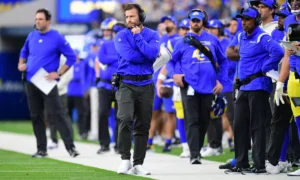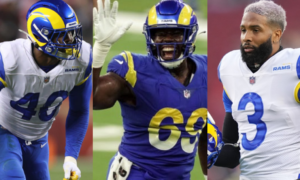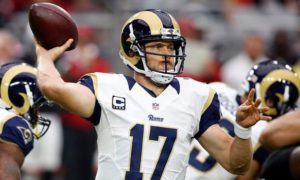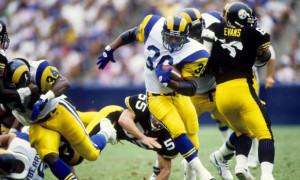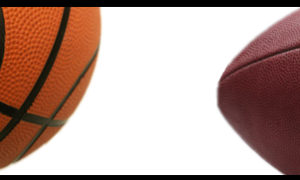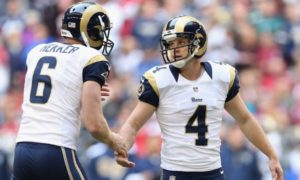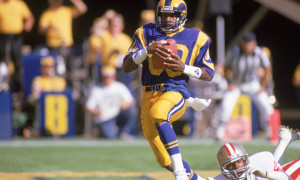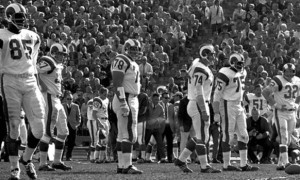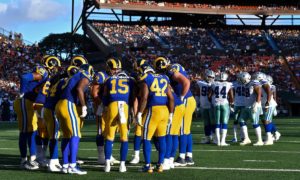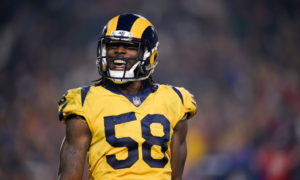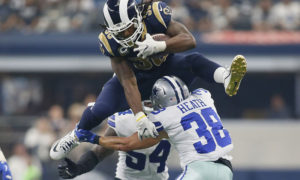The Los Angeles Rams not only signed the first black players in the modern NFL, but they continued to break the mold of the old league. They brought on the first player from a historically black college. The other players grew up in the Los Angeles area and played collegiate ball at local universities. These African-American L.A. Rams were not only trendsetters, but they were an integral part of the team that took the NFL by storm, winning the 1951 NFL Championship. It would be the first ever major sports championship on the West Coast. Dan Towler, Paul Younger, Bob Boyd, Woodley Lewis and Harry Thompson cemented the Rams as a force in diversity, unity, strength, courage, innovation and talent.
“Deacon” Dan Towler (FB) – Washington and Jefferson College (PA)
Towler is one of the greatest Rams running backs of the 1950s era. He was one of three members of the famous “Bull Elephant” backfield, which included Paul “Tank” Younger and Dick Hoerner. In the Rams’ 1951 NFL Championship season, he had 126 carries for 854 yards and six touchdowns. One of his runs was for 79 yards in a win against the Green Bay Packers. The Rams won 28-0. He also had 16 receptions for 257 yards that season. It was Towler that rushed for a 1-yard touchdown in the championship against the Cleveland Browns, giving the Rams a 14-10 lead in the third quarter.
At 6’2,” 225 pounds, Towler was drafted by the Rams out of Washington and Jefferson College in 1950. He was the 324th player taken in the 25th round. While in his junior year at Washington and Jefferson, Towler led the nation in scoring in his division. In his rookie season, the Rams made it to the 1950 NFL Championship, although the Rams did lose to the Browns by a field goal, 30-28. Towler finished his NFL career with 44 touchdowns in six seasons. He was also a four-time Pro Bowler. His career best season was 1952. Towler led the NFL with 156 carries for 894 yards and 10 touchdowns. He scored 11 touchdowns in 1954 with a long of 73 yards.
While with the Rams, Towler studied for his master’s degree in theology from the University of Southern California. As a rookie, Towler asked head coach Joe Stydahar if he could lead the team in a pregame prayer. Stydahar allowed it and the Rams became the first NFL team to pray before games. Towler even earned the nickname “Deacon.” He was proud to leave that legacy with the league and believed it helped with team camaraderie and fellowship. Towler eventually became the pastor of Lincoln Avenue Methodist Church in Pasadena, California after retiring from football in 1955. He was also a campus minister at California State University, Los Angeles and a six-term president of the Los Angeles County Board of Education.
Paul “Tank” Younger (FB/LB) – Grambling College (LA)
Younger is the first player from a historically black college to play in the NFL. He also joined Towler, Lewis, Boyd and Thompson as one of the first black players in the league. He was a star at Grambling College (now Grambling State University) in Louisiana where he played offensive tackle and running back. Younger scored 60 touchdowns in his four seasons at Grambling, but was never drafted by the league. At the recommendation of his coach Eddie Robinson, Tank made the trek to California to try out for the Rams. He made the team as a free agent in 1949.
The 6-foot-3-inch, 225-pound Younger played both ways as a running back and linebacker for the Rams. In his rookie season, he was the only black player on the roster. He had 52 carries for 191 yards and seven receptions for 119 yards in 1949. In 1950, Younger saw Towler, Boyd, Lewis and Thompson added to the roster, increasing the number of African-American players on the Rams to five. He scored one touchdown during the 1951 season. It was a 20-yard run against the Chicago Bears, giving the Rams a 42-17 lead in the fourth quarter. Younger was mainly used on defense in 1951 and 1952.
Younger’s best years with the Rams would come later. In 1953, he had 84 carries for 350 yards and eight touchdowns and 20 catches for 259 yards and one touchdown. In 1954, he had 91 carries for 610 yards and eight touchdowns. But Younger saw his most carries in 1955 with 138 for 644 yards and five touchdowns. He had 31 career TDs in his eight years with Los Angeles, appearing in four NFL Championship games during that era (1949, 1950, 1951 and 1955). Younger went to the Pittsburgh Steelers for his final 1958 season where he had 88 carries for 344 yards and three touchdowns. He also had 16 catches for 188 yards. Younger was a five-time Pro Bowler. He retired as a Steeler and eventually became a scout for the Rams. He also became the league’s first black assistant general manager with the San Diego Chargers from 1975-1987. He then rejoined the Rams’ front office in several administrative positions before retiring in 1995.
Bob Boyd (WR/DB/PR/KR) – Loyola Marymount University (CA)
Boyd was a modern marvel of a player on all phases of the ball. Although the 1951 season was not Boyd’s best, he deserves a place in Rams history as a part of the stellar receiving and defensive back corps of the 1950s. He also returned punts and kickoffs throughout his time with the Rams.
In the 1950 season, he played primarily in garbage time where the Rams scored 65 points or more. Boyd had nine receptions for 220 yards and four touchdowns. His longest touchdown pass was a 72-yard pass from quarterback Bob Waterfield in a 28-21 win over the San Francisco 49ers. He also had two touchdown passes in a 70-27 thrashing over the Baltimore Colts.
In 1951, Boyd caught nine passes for 128 yards and one touchdown. The touchdown came from a 28-yard pass from Waterfield in a 31-21 loss to the Washington Redskins. That season, he also had two interceptions as a defensive back.
Boyd’s best season came in 1954 where he caught 53 passes for 1,212 yards and six touchdowns. Three of those scores included an 80-yard bomb and two 71-yard passes from quarterback Norm Van Brocklin. Boyd also led the NFL in receiving yards that year. During his career with the Rams, he was considered the fastest split-end receiver in the NFL.
While at LMU, Boyd played three sports: football, track and field and boxing. He won the NCAA National Championship in 1950 for the 100-yard dash. He also set school records that year for running the 100-yard dash in 9.6 seconds and the 220-yard dash in 21.5 seconds.
After retiring from football, he used his economics degree in the business world as an executive for many companies. He started his own financial firm, Financial Services Organization, from where he retired in 1977.
Woodley Lewis (PR/KR/DB/WR/RB) – University of Oregon
Lewis is another two-way player that helped the Rams reach the 1950 Championship game and earn their 1951 Championship title. He especially shined on defense and led the NFL with 12 interceptions in his rookie 1950 season. Lewis had a 50-yard fumble touchdown recovery against the Packers that season.
The University of Oregon graduate did not reach the end zone in the 1951 season, but he did have three interceptions. In 1953, Lewis had seven interceptions, one for a 45-yard touchdown return in a 37-24 win against the Detroit Lions. He also played several positions on the Rams, including running back between the 1952 and 1954 seasons. Lewis had 47 carries for 188 yards.
Lewis was a dominant return specialist too. In 1952, Lewis had his best punt return season with 19 returns for 351 yards and two touchdowns. His longest score was an 82-yard return in a 35-9 win against the 49ers. In 1953, he had 35 returns for 267 yards and one touchdown. That touchdown was a 78-yard return in a 31-19 win against the Lions. Lewis also had 32 kick returns for 830 yards that year. But his best best kick return stats came in 1954 when he had 34 returns for 836 yards and one touchdown. The 88-yard touchdown return came during a 28-17 win against the Chicago Cardinals.
Ironically, Lewis was traded to the Cardinals after six seasons with the Rams. Throughout his career with the Rams and the Cardinals, he also caught 123 passes for 1,885 yards and 12 touchdowns. After the NFL, he became a respected community leader working with youth organizations in South-Central Los Angeles. Lewis also invested in and co-owned the Sportsman’s Bowl bowling alley in Los Angeles in 1962.
Harry Thompson (RG) – UCLA
Thompson may not get the glory on paper, but his blocking was key in the 1951 NFL Championship victory over the Browns. He was a great blocker for the “Bull Elephant” backfield. His self-sacrificing nature and work ethic in training camp was noticed by the entire team.
Thompson and the other black players on the Rams endured racism while traveling for away games. In Washington, D.C., they were not allowed to eat at the hotel restaurant and had to order room service instead. He played for the Rams from 1950 to 1954 and then for the Cardinals in 1955.
After retiring from football, Thompson became an activist for old-time football player pension benefits, specifically pre-1959 players. He was president of the NFL Alumni Inc. for one year and collected 1,600 signatures to get pre-1959 players more benefits.
The Legacy They Left Behind
The pioneering five that found themselves on the Rams’ 1951 roster made them an exceptionally diverse team. They showcased superstar players that continued to break race barriers and change the playing style. The Rams later added Dick “Night Train” Lane to the roster on defense from 1952 to 1953. Boyd missed the 1952 season due to military service, but Lane’s second season would make it six total African-American players on the Rams in 1953.
Not only did these players help bring a championship to California, but they helped the Los Angeles Rams become the first champions in a major sport west of the Mississippi. The Rams moved to California preceded the Los Angeles Dodgers by 12 years and Los Angeles Lakers by 14 years.
Sources: LAtimes.com, NOLA.com, NYtimes.com, Pro-football-reference.com, Riversidesporthalloffame.com, Thesportscol.com
You can follow Erik Ho on Twitter @EHoinSDLVLA. Be sure to follow Rams Talk on Twitter @TalkRams.

